The bulk of the talk about the 2020 Porsche Taycan Turbo has to do with its stupendous electric powertrain. I’m not complaining, mind you, because the attention is fully justified. I, too, am super geeked about its 800-volt architecture, its coaxial direct drive front motor and the two-speed transmission that’s fitted to the bruising motor that powers it from the rear. There’s an abundance of range talk, too, some of which I’m guilty of myself.
But let’s move beyond that for a moment. The Taycan Turbo is a supremely good handler in its own right. It also rides exceptionally well over just about any surface and feels utterly composed at all times. One can instantly transmogrify a Taycan from Dr. Bruce Banner to The Hulk by merely stomping on the not-loud-at-all pedal. Putting the purchase price aside, it is my new favorite Porsche. I don’t even have to qualify it that way because, well, I can’t afford any of them anyway.
So what makes it so good? Clever engineering by clever engineers, of course. Let’s crawl underneath and see what that looks like.
(Read other Suspension Deep Dives)
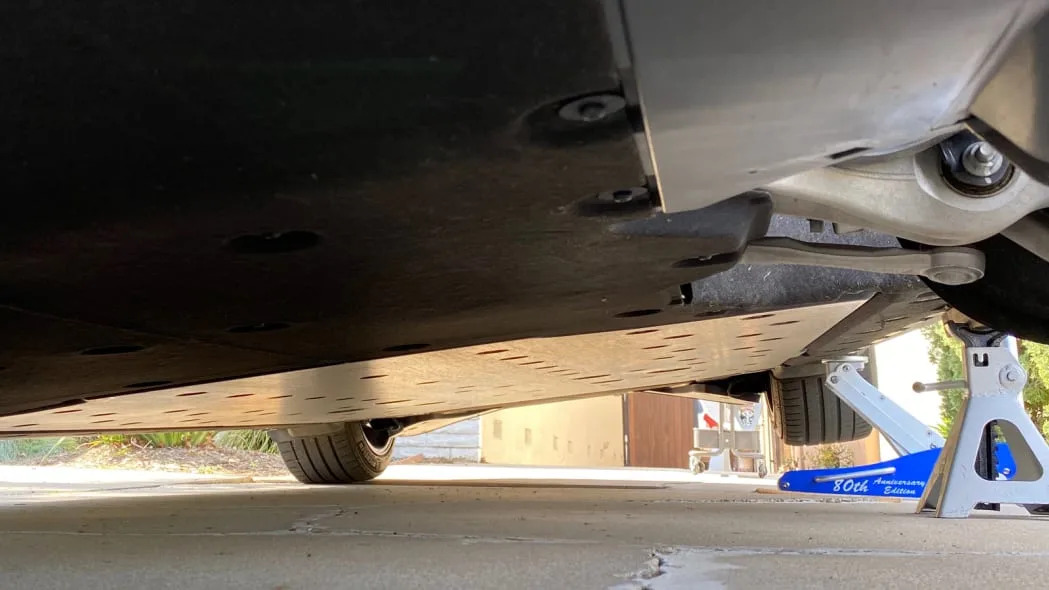
The Taycan’s platform is distinctive for a Porsche because the entire floor structure is built to house a massive 93.4-kilowatt-hour battery pack. The front and rear electric motors are supported within entirely new suspension subframes, too. But Porsche was able to locate the suspension pickup points in familiar places so that a number of Panamera-derived bits could be bolted on.
But they’re not entirely the same. The Taycan is 1.1 inches wider in order to properly house the battery and its electric motors, and as a result, the suspension pickup points and the tire contact patches stand farther apart than they are in a Panamera. Adjustments also had to be made because the underslung battery makes this smaller car weigh about 500 pounds more than a Panamera Turbo. Its presence also alters the Taycan’s center of gravity to the point where it is the lowest in the entire Porsche catalog. And lest we forget, the suspension must also deal with electric motors that are able to deliver their massive wallop of peak torque pretty much instantly.
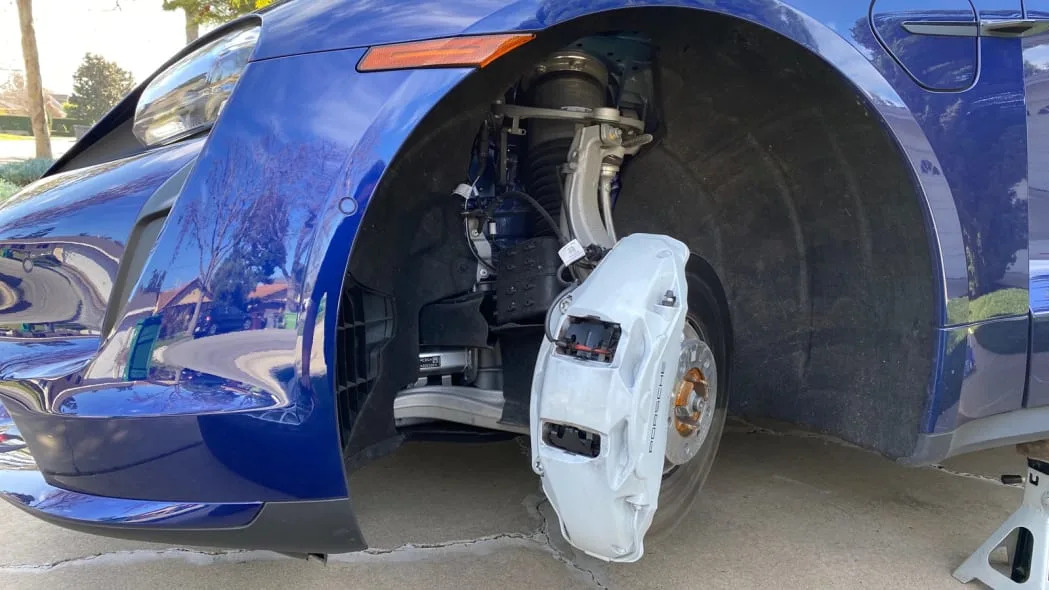
The front end has undergone more changes than the rear from Panamera. The track width increase is generally greater up here, but the bigger influence is the absence of a hulking internal combustion engine. There are dimensional differences as well, most notably a shorter wheelbase and overall length.
Those last differences do impact what we’re looking at because they conspire to reduce the space available for the double wishbone front suspension we see here, particularly the mounting points at the upper end.
But I can see that those brake calipers are distracting you. Let’s get them out of the way before we move on.

That’s a size 13 shoe. That rotor is just over 16.5 inches in diameter, and we can clearly see that the span of the caliper is broader than that. This is an Akebono-supplied 10-piston fixed caliper, and I have indicated the five pistons that reside on the near side. The bleed ports and crossover tube are just above and below them, and the rest of the metal is there to give the caliper stiffness and keep it from jacking itself open.
At first, this was all a bit peculiar to me. The Taycan can generate a monstrous 0.39 g of regenerative braking via the magnetism in its electric motors. That’s enough to handle all but the most aggressive street stops, and Porsche suggests that about 95 percent of the time, these calipers are just along for the ride. The recommended replacement interval is six years, and that’s a safeguard against corrosion effects; they’d last much longer otherwise. Likewise, that shiny coating is there to ensure the rotors always look good and never corrode despite pads that will oftentimes be out of the loop and unable to keep them scrubbed.
Why so massive, then? Two reasons come to mind. This is a driver’s car that begs to be driven hard. You’ll need good brakes when you cane it in the mountains. But even that might not even register unless you’re on a real racetrack. The other reason was made clear to me on Germany’s Autobahn. There we were, sailing along (legally) at 167 mph, when someone pulled into our lane doing 70 mph. All 10 pistons in these Akebonos made instant sense in one sudden brake application.

Admit it. You’re still staring at the brake caliper.
The upper wishbone (green arrow), lower wishbone (yellow) and steering knuckle are all lightweight aluminum alloy pieces. Get used to it, we’ll be seeing a lot of that.
Still, there are numerous shields keeping us from getting a clear view. Let’s try another angle.
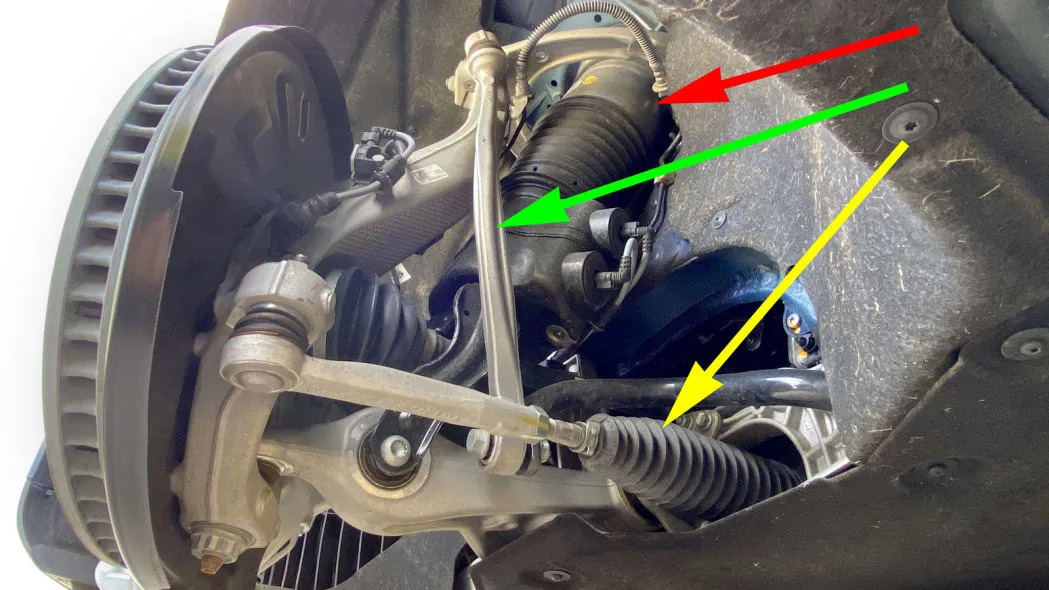
That’s better. The view from behind is much more open. Now we can see the air spring (red), the stabilizer bar connecting link (green) and the rear-mounted steering rack (yellow). If you’re thinking something is missing, you’re right. We can’t see the front shock because that’s hidden within the air spring. Bag-over shocks, anyone?

Dimension-wise, this upper mounting point is lower in the Taycan than it is in a Panamera. This difference results in the need for a shorter spring/shock assembly and a shorter steering knuckle. The arrow indicates the height sensor that feeds back position data to the air suspension and other systems.
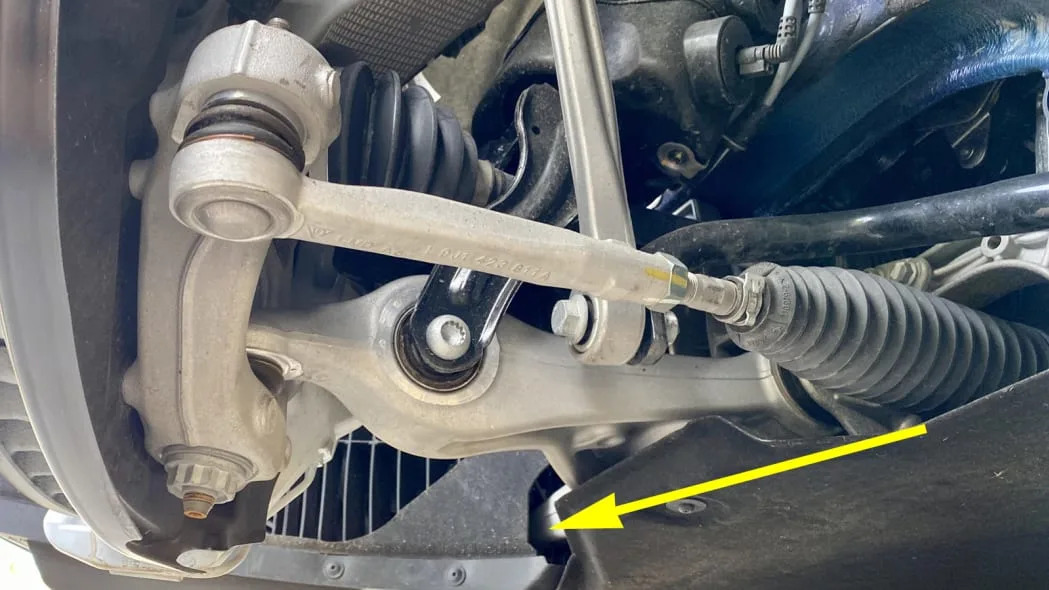
The close-up shows how the steering linkage is mounted behind the front axle centerline. This view also shows the lower wishbone’s forward pivot point is hidden in shadows behind the fender liner, as indicated by the arrow.

It’s tight in there, but we can see where the steering column’s output shaft (yellow) connects to the steering rack.
But the stabilizer bar is the star here. Its pivot point (green) obscures the PDCC mechanism that’s buried out of sight. PDCC stands for Porsche Dynamic Chassis Control, a system of stabilizer bars with couplings in the middle to improve performance in two ways. On uneven straight roads the coupling will slacken to reduce the effectiveness of the stabilizer bar and improve head toss. When it’s time to boogie the system can overdrive the stabilizer bars to make them behave as if they were bigger to greatly reduce body roll in corners.
The software is theoretically able to reduce body roll to zero and even make a car lean into turns, but Porsche doesn’t take it that far because their in-house driving aces say it starts to feel unnatural.
Meanwhile, the link (red) is what connects the stabilizer bar to the moving elements of the suspension.
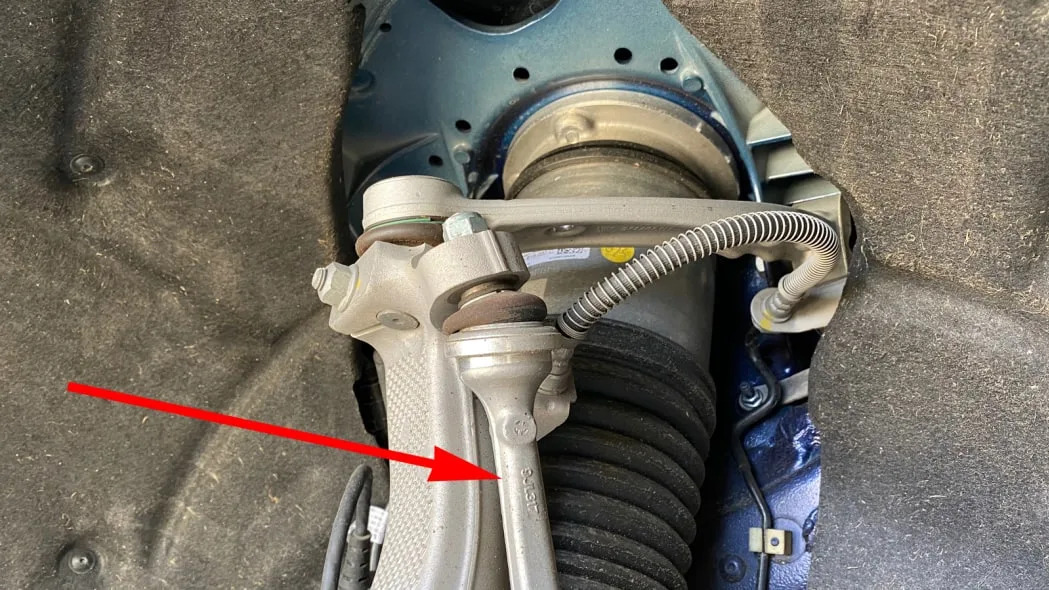
The stabilizer link connects to the steering knuckle right at the top upper wishbone, a routing that keeps it well out of the way of the tire as it moves back and forth in turns. Its connection to the steering knuckle also makes it as efficient as possible because it creates a motion ratio of 1-to-1 with respect to suspension movement.

There is brake cooling ductwork in the nose of the car, and it exits here. The two parts don’t seem to line up, but that’s because I’ve got the car jacked up with the wheel hanging at full droop. These two will line up much better with the car on the ground, and the extra width of the outer piece is there to accommodate a normal amount of suspension travel.

The Taycan’s air springs employ a three-chamber design that allows for more spring rate adjustability than the two-chamber system used on the Panamera. The system can produce different behaviors in Normal, Sport and Sport Plus, and it offers different ride heights that are either tied to these selections, to vehicle speed or to specific driver selections. For example, the car will generally lower itself 20 mm when cruising at highway speeds, but that height is also the standard running condition if you select Range mode, as I did in the recent Taycan range test.
We’re only seeing air inlet and outlet hoses here. The valving that controls what happens in the three chambers is hidden out of sight behind those prominent covers.

Moving to the rear, we can see that the Taycan has multi-link rear suspension, a catch-all description that’s used liberally when there aren’t two distinct wishbones to point at. Multilink doesn’t mean one specific layout, in other words.
This one has one wishbone at the bottom that we can’t yet see, but here at the top we can see two links (yellow) that are arranged to approximate a wishbone. They envelop a slender shock absorber and the bulkier rear air spring. Up towards the front there’s a toe link (green) with a peculiar look to it.
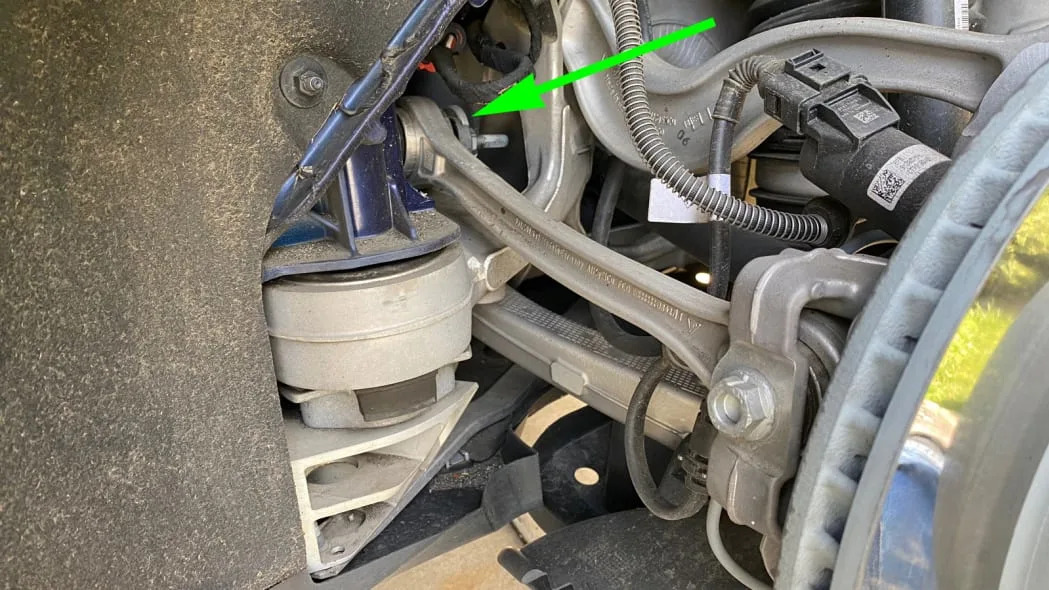
Look closely and you’ll notice that the inner end (green) isn’t connected to the subframe. That’s because this car has the rear steering option. The actuator that moves this link in and out is buried deep just beyond the edge of sight, like everything else in this tightly packaged car. The actuator doesn’t moves the link all that much because a little goes a long way when steering at the back, as anyone who’s ever driven a forklift or tried to back up a car at any rate of knots can attest.
If this car didn’t have rear steer, the subframe would have an extra pickup point we’d be able to plainly see from this vantage point.
There is one part that bothers me about all of this. The eccentric you need to loosen to set static toe-in is on the inner end, also near the arrow. I can’t tell for sure, but it looks like it’d be a real pain to adjust rear toe on this car.
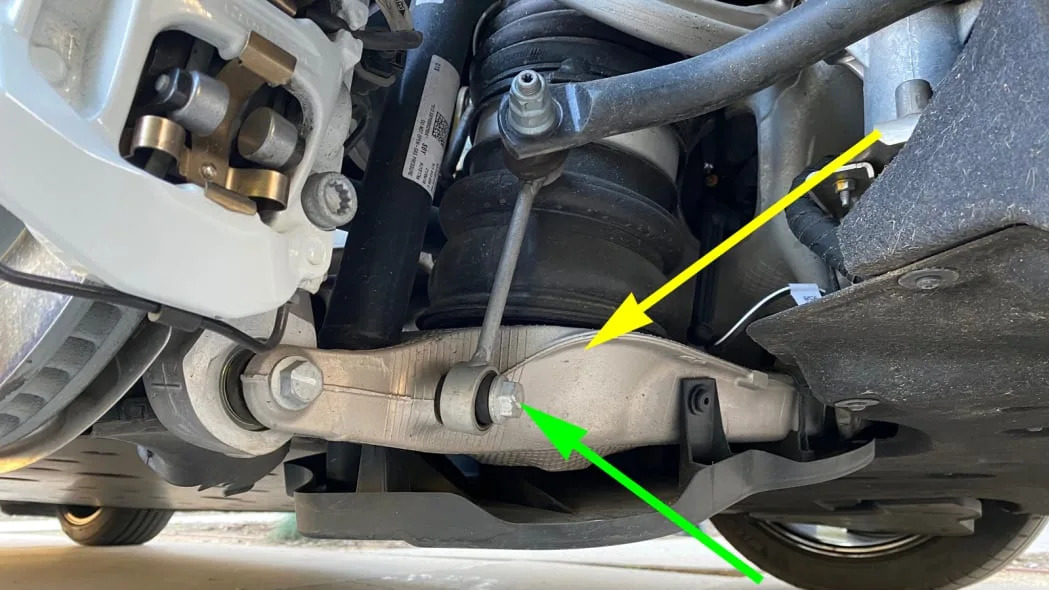
This lower view shows the lower wishbone (yellow), but there’s a plastic cover that hides its true shape. It’s also worth noting that all of the links we’ve seen so far, as well as the rear hub carrier, are aluminum. I wouldn’t expect anything less from these guys.
I do appreciate the clever two-birds-with-one-stone aspect of the stabilizer bar attachment (green), which shares a bolt with the lower shock absorber mounting point. Saves parts, eases assembly. And it saves me the trouble of estimating two motion ratios because they’ll be identical.

Speaking of motion ratios, here they are in all their glory. The spring appears to work at an approximate 0.6-to-1 ratio, which means it’ll move six tenths of an inch for every inch of wheel travel. The twinned mounting of the stabilizer bar link and the shock absorber looks to be a bit more efficient at about 0.8-to-1. Meanwhile, the inner pivot has an easily accessed eccentric for camber adjustment.

Like the front, the rear PDCC mechanism that does all the roll-control magic is hidden from view behind its pivot bushing and other items. Unlike the front, the rear stabilizer link is a slender steel affair instead of some grandiose aluminum piece wrought of fire. That’s because this link is much shorter and has a very favorable slenderness ratio. It also doesn’t hurt that the rear stabilizer bar isn’t as hefty as the front one, and we can’t forget its motion ratio is lower, too.
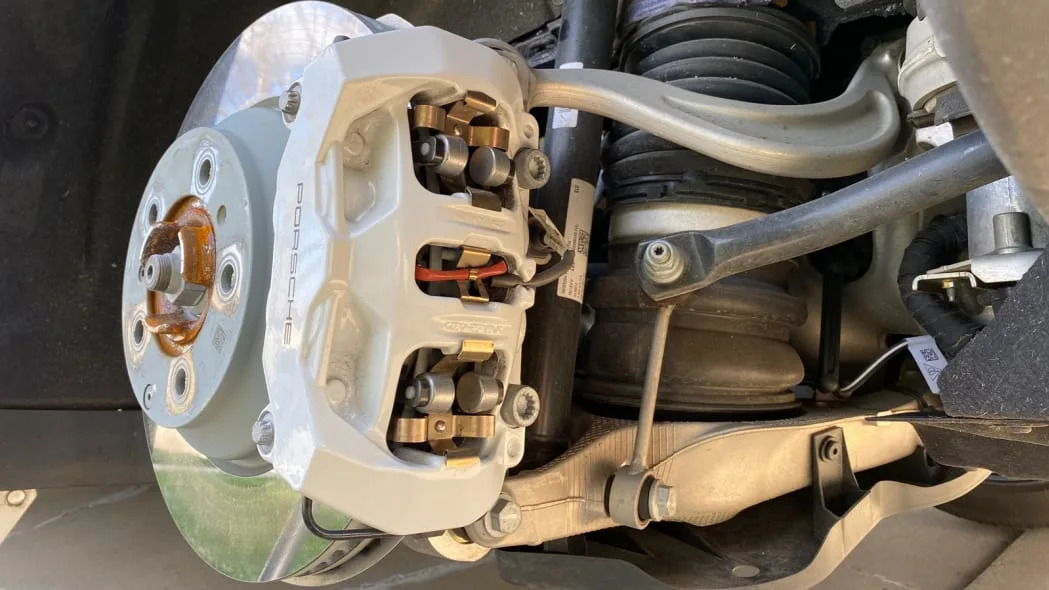
The Taycan’s rear brakes are modest four-piston fixed calipers, which is fine because less braking happens at the back end of this or any other vehicle. Looks nice, though.

Even though there’s not much to see, there’s a lot going on here. We finally found a vantage point where the other end of the lower wishbone (yellow) is almost, but not quite, visible. It’s a theme with this car.
The plastic aero covers (green) are the culprits this time, but they do look cool as they smooth out the underbody airflow behind the battery back. The only gap in their coverage is for the snorkels that direct cool air onto the rear brake rotors (blue).

The Taycan Turbo is fitted with 20-inch wheels wrapped with 245/45R20 sized tires in front and 285/40R20 in back. You can get all-season Continentals or Michelin Pilot Sport 4 summer (more like three-season) tires for the same price. Yes, Porsche has one no-cost option. Who knew?
This Taycan had the latter. And like I always do because I have them off anyway, I weighed them to see what the wheel/tire combo contributes to unsprung mass. They obviously went to a lot of trouble with all of the aluminum suspension bits, but how’d they do here? Not bad, considering their size. The front assemblies weigh 60 pounds and the rears weigh 66 pounds.
The Taycan is seriously dense in terms of its packaging and technical content. It takes a lot of clever engineering and experience to pack all that we’ve seen (along with much that was still hidden) into a car that can perform mightily, keep itself cool when subjected to hard use, stay reliable, be easy to build, and still look so damn graceful and effortless when viewed from above. Hats off, Porsche.
Contributing writer Dan Edmunds is a veteran automotive engineer and journalist. He worked as a vehicle development engineer for Toyota and Hyundai with an emphasis on chassis tuning, and was the director of vehicle testing at Edmunds.com (no relation) for 14 years.
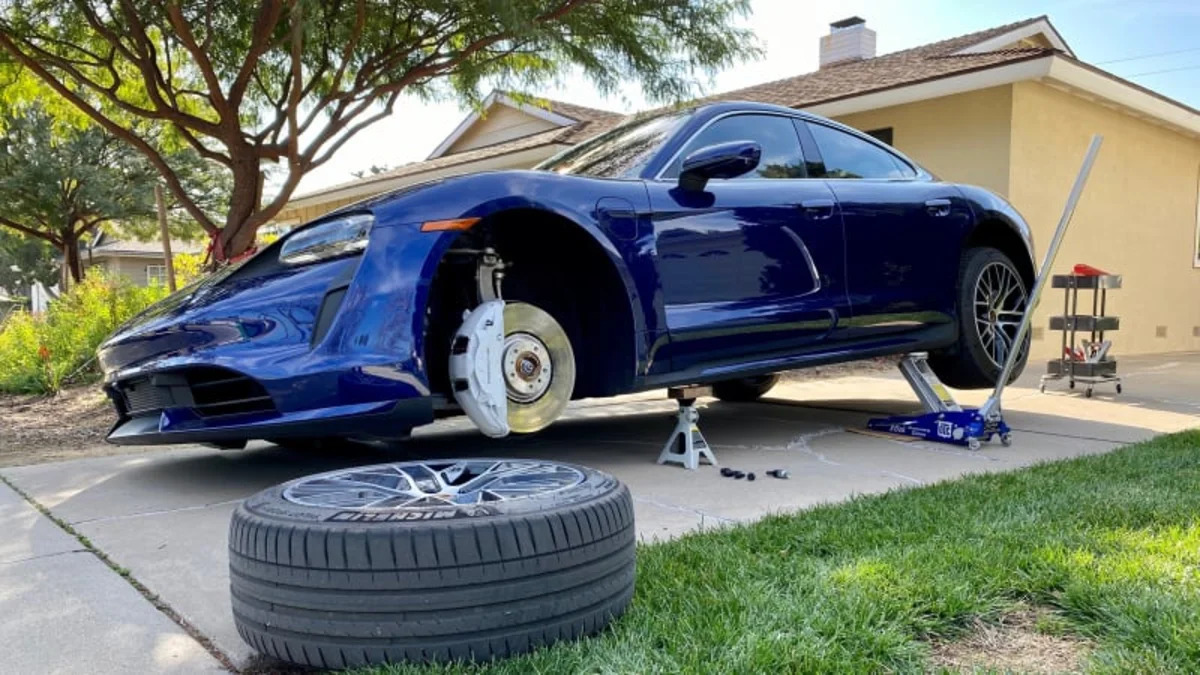
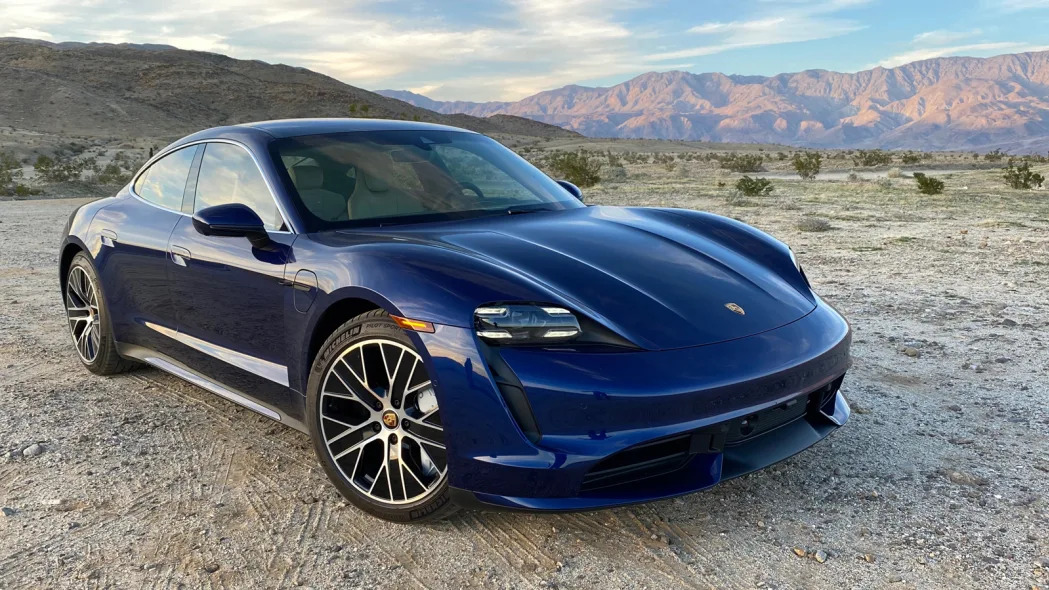

Sign in to post
Please sign in to leave a comment.
Continue